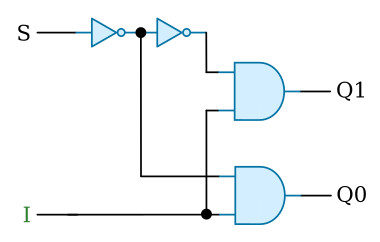Home > Textbooks > Basic Electronics > Combinational Logic > Demultiplexer >
Combinational Logic
Demultiplexer
A demultiplexer is an electronic logic circuit that allows a single input to be passed to any one of several outputs. A demultiplexer can be thought of as the opposite of the multiplexer. Just as a multiplexer selects multiple inputs and connects to a single output, a demultiplexer connects multiple outputs to a single input. For this reason it is sometimes called a data distributor.
Demultiplexer Applications
In addition to the demultiplexers value as a distributor of data among output lines, the demultiplexer can accept a serially-transferred word a bit at a time and transfer these bits into a shift or storage register at the output of a demultiplexer. Once all of the bits have been shifted to the register, the word is now available for parallel transfer. A demultiplexer is useful in this mode as a serial-to-parallel converter.
2-Input Demultiplexer Using Gates
The circuit below is a simple form of digital demultiplexer constructed from logic gates. It has one data input (I) and two outputs (Q0 and Q1). The control input S selects which output will be enabled. When S is logic 0, the demultiplexer will pass the data input to output Q0, while Q1 will be disabled (logic 0). When S is set to logic 1, the demultiplexer will pass the data input to output Q1, while Q0 will be disabled (logic 0).







